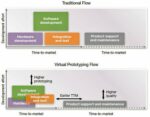You are currently viewing SemiWiki as a guest which gives you limited access to the site. To view blog comments and experience other SemiWiki features you must be a registered member. Registration is fast, simple, and absolutely free so please,
join our community today!
Dan is joined by Andrea Gallo, CEO of RISC-V International, the non-profit home of the RISC-V instruction set architecture standard, related specifications, and stakeholder community. Prior to joining RISC-V International, Gallo worked in leadership roles at Linaro for over a decade. He built Linaro’s server engineering… Read More
Part 2 of this 4-part series reviews the role of virtual prototypes as stand-alone tools and their use in hybrid emulation for early software validation, a practice known as the “shift-left” methodology. It assesses the differences among these approaches, focusing on their pros and cons.
The Immensity of Software Development… Read More
Designers have many paths for differentiating RISC-V solutions. One path launches into various RISC-V core customizations and extensions per the specification. Another focuses on selecting and assembling IP blocks in a complete system-on-chip (SoC) design around one or more RISC-V cores. A third is emerging: interconnecting… Read More
Many modern processor performance benchmarks rely on as many as three levels of cache staying continuously fed. Yet, new data-intensive applications like multithreaded generative AI and 4K image processing often break conventional caching, leaving the expensive execution units behind them stalled. A while back, Semidynamics… Read More
The flexibility of RISC-V processor IP allows much freedom to meet specific requirements – but it also opens the potential for many bugs created during the design process. Advanced processor features are especially prone to errors, increasing the difficulty and time needed for thorough verification. Born out of necessity, … Read More
Modern CPU performance hinges on keeping a processor’s pipeline fed so it executes operations on every tick of the clock, typically using abundant multi-level caching. However, a crop of cache-busting applications is looming, like AI and high-performance computing (HPC) applications running on big data sets. Semidynamics… Read More
In the previous blogs on this topic, we’ve seen that utilizing near-threshold voltage (NTV) saves incredible amounts of energy, theoretically up to 10x and in practice from 2x to 4x. But there is a price which makes some applications more suited for NTV than others. This is due to the inevitable performance (speed) loss of NTV as … Read More
The semiconductor intellectual property (SIP) market is an integral part of the semiconductor industry. Third-party IP has propelled the industry, opening the door for many new products from start-ups to established IDMs. Enabling increasingly complex devices, reducing the cost of product development and reducing the time… Read More








